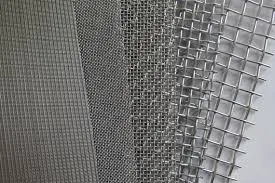-
+86 15030157877
-
sales@galvanizedmetalmesh.com
Dec . 11, 2024 05:57 Back to list
Innovative Applications and Benefits of Welded Wire Mesh in Construction and Design
Understanding Welded Mesh Versatility and Applications
Welded mesh, also known as welded wire mesh, is a type of fencing or reinforcement material made from wires that are welded together in a grid pattern. This construction technique gives it strength and durability, making it an essential component in various construction and industrial applications. Featured in a myriad of sizes and specifications, welded mesh offers a balance of affordability, functionality, and aesthetic appeal.
Manufacturing Process
The production of welded mesh involves a meticulous process where high-quality wire is drawn, cut, and then arranged in a grid shape. The wires are welded at the intersection points using electric resistance welding, which provides a strong bond and ensures structural integrity. After welding, the mesh can be galvanized or coated with other materials to enhance its corrosion resistance, making it suitable for both indoor and outdoor uses.
Types and Specifications
Welded mesh is available in numerous configurations, including different wire diameters, mesh sizes, and materials. Common types include
1. Welded Wire Fencing Used primarily for security and boundary protection around properties, agricultural lands, gardens, and construction sites. This type often features taller heights and a more robust design to deter trespassers and animals.
2. Reinforcement Mesh Employed in concrete structures, reinforcement welded mesh adds tensile strength to concrete slabs, walls, and beams. It minimizes the risk of cracking, ensuring longevity and stability in construction projects.
3. Animal and Poultry Enclosures Welded mesh is also widely used in the agricultural sector for creating cages, pens, and enclosures for animals. Its sturdiness keeps livestock safe from predators while allowing for ventilation and visibility.
welded mesh

4. Decorative Panels Beyond functionality, welded mesh can be used for decorative purposes. Designers and architects incorporate it into building facades, fences, and interior spaces due to its modern aesthetic appeal while maintaining safety and utility.
Applications Across Industries
The versatility of welded mesh means it serves various industries. In construction, it is a critical component for roadworks, bridges, and buildings, ensuring that structures can withstand environmental stresses. The agricultural sector utilizes welded mesh for fencing, livestock containment, and support in gardening applications such as trellises for climbing plants.
The automotive and aerospace industries also leverage welded mesh for components where strength and lightweight characteristics are essential. In transportation, it can be seen in guardrails and protective barriers.
Benefits of Welded Mesh
The numerous advantages of welded mesh make it a go-to choice for many applications. Its strength and durability mean that it requires minimal maintenance while providing long-lasting performance. The welded construction minimizes gaps, enhancing security and safety. Additionally, its lightweight nature allows for easy handling and installation, making it a practical choice for contractors and DIY enthusiasts alike.
Conclusion
In conclusion, welded mesh is a multifaceted material that plays an essential role in modern construction and manufacturing. Its adaptability across various sectors, combined with its strength and durability, positions it as a reliable solution for a diverse range of applications. Whether protecting properties, reinforcing concrete, or serving aesthetic purposes, welded mesh continues to be a favorite in both industrial and domestic uses. Understanding the unique attributes and benefits of welded mesh can help individuals and businesses make informed choices for their specific needs, optimizing both functionality and cost-effectiveness.
-
Hexagonal Gabion for River Bank Protection and Retaining Walls
NewsJul.23,2025
-
Chain Link Fence-HEBEI WEICHUN WIRE MESH TRADE CO.,LTD.|durable fencing solutions&secure perimeter protection
NewsJul.23,2025
-
High Quality Stainless Steel Wire Mesh Roll & Supplier Wholesale Price
NewsJul.22,2025
-
Hexagonal Gabion Mesh: Durable Stone Cages for Landscaping
NewsJul.22,2025
-
Premium Black Brick Welded Mesh - High Strength & Corrosion Resistant
NewsJul.21,2025
-
High-Quality Chicken Wire Panels Leading Manufacturer & Exporter
NewsJul.08,2025



